By Joseph D’Aleo, Weatherbell.com
The ozone hole above the Antarctic has reached its maximum extent for the year, revealing a gouge in the protective atmospheric layer that rivals the size of North America, scientists have announced.
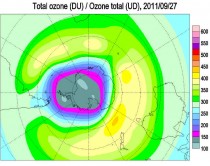
Spanning about 9.7 million square miles (25 million square kilometers), the ozone hole over the South Pole reached its maximum annual size on Sept. 14, 2011, coming in as the fifth largest on record. The largest Antarctic ozone hole ever recorded occurred in 2006, at a size of 10.6 million square miles (27.5 million square km), a size documented by NASA’s Earth-observing Aura satellite.
The Antarctic ozone hole was first discovered in the late 1970s by the first satellite mission that could measure ozone, a spacecraft called POES and run by the National Oceanic and Atmospheric Administration (NOAA). The hole has continued to grow steadily during the 1980s and 90s, though since early 2000 the growth reportedly leveled off. Even so scientists have seen large variability in its size from year to year.
On the Earth’s surface, ozone is a pollutant, but in the stratosphere it forms a protective layer that reflects ultraviolet radiation back out into space, protecting us from the damaging UV rays. Years with large ozone holes are now more associated with very cold winters over Antarctica and high polar winds that prevent the mixing of ozone-rich air outside of the polar circulation with the ozone-depleted air inside, the scientists say.
There is a lot of year to year variability, in 2007, the ozone hole shrunk 30% from the record setting 2006 winter.
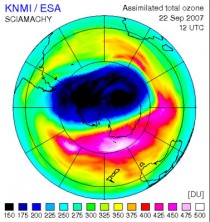
The record setting ozone hole in 2006 (animating here).
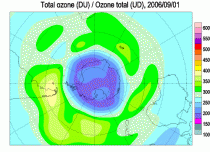
In 2007, it was said: “Although the hole is somewhat smaller than usual, we cannot conclude from this that the ozone layer is recovering already,” said Ronald van der A, a senior project scientist at the Royal Dutch Meteorological Institute in the Netherlands.
This year, the ozone region over Antarctica dropped 30.5 million tons, compared to the record-setting 2006 loss of 44.1 million tons. Van der A said natural variations in temperature and atmospheric changes are responsible for the decrease in ozone loss, and is not indicative of a long-term healing.
“This year’s (2007) ozone hole was less centered on the South Pole as in other years, which allowed it to mix with warmer air,” van der A said. Because ozone depletes at temperatures colder than -108 degrees Fahrenheit (-78 degrees Celsius), the warm air helped protect the thin layer about 16 miles (25 kilometers) above our heads. As winter arrives, a vortex of winds develops around the pole and isolates the polar stratosphere. When temperatures drop below -78C (-109F), thin clouds form of ice, nitric acid, and sulphuric acid mixtures. Chemical reactions on the surfaces of ice crystals in the clouds release active forms of CFCs. Ozone depletion begins, and the ozone “hole” appears.
Over the course of two to three months, approximately 50% of the total column amount of ozone in the atmosphere disappears. At some levels, the losses approach 90%. This has come to be called the Antarctic ozone hole. In spring, temperatures begin to rise, the ice evaporates, and the ozone layer starts to recover.
Intense cold in the upper atmosphere of the Arctic last winter activated ozone-depleting chemicals and produced the first significant ozone hole ever recorded over the high northern regions, scientists reported in the journal Nature.
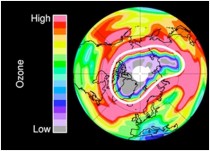
This year, for the first time scientists also found a depletion of ozone above the Arctic that resembled its South Pole counterpart. “For the first time, sufficient loss occurred to reasonably be described as an Arctic ozone hole,” the researchers wrote.
It was related to a rebound cooling of the polar stratosphere and upper troposphere. Notice the December and early January warmth and VERY NEGATIVE AO and the pop of the AO and rapid cooling starting in January.

The Antarctic after a record negative polar warming, turned colder in mid to late winter (starting in late August).
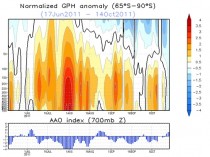
Also note the scientists mentioning the sulfuric acid mixture’s role in the ozone destruction. Sulfate aerosols are associated with volcanism and the recent high latitude volcanoes in Alaska, Iceland and Chile may have contributed to the blocking (warming). Like a pendulum, a swing to one state, can result in a rebound to the opposite extreme very obvious in the arctic.
The data shows a lot of variability and no real trends after the Montreal protocol banned CFCs. The models had predicted a partial recovery by now. Later scientists adjusted their models and pronounced the recovery would take decades. It may be just another failed alarmist prediction.
Remember we first found the ozone hole when satellites that measure ozone were first available and processed (1985). It is very likely to have been there forever, varying year to year and decade to decade as solar cycles and volcanic events affected high latitude winter vortex strength. PDF.




